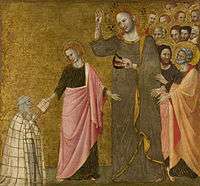Clare of Rimini
Clare of Rimini, born as Chiara Agolanti, was born at Rimini in 1282 and died there on February 10, 1346.
Clare of Rimini | |
|---|---|
 The Vision of the Blessed Clare of Rimini / Francesco da Rimini (Master of the Blessed Clare). ca. 1333-1340. | |
| Born | 1282 Rimini |
| Died | 10 February 1346 Rimini |
| Venerated in | Roman Catholicism |
| Beatified | Equipollent 1782 by Pope Pius VI |
| Major shrine | Rimini |
| Feast | 10 February (in Rimini) |
Life
Chiara Agolanti was born to a wealthy family of Rimini. Married at a young age, she was sent into exile upon the death of her husband. Upon her return, she witnessed the hanging of her father and brother by a rival political faction. She remarried and lived a life of pleasure and dissipation.[1]
According to the Stephen Donovan, one day when she was thirty-four, she attended Mass in the church of the Franciscan Friars, she seemed to hear a mysterious voice that bade her say an Our Father and a Hail Mary at least once with fervour and attention. Clare obeyed the command, not knowing from where it came, and then began to reflect upon her life.[1]
She decided to enter the Third Order of St. Francis, and became a model of every virtue, but especially of charity towards the destitute and afflicted. She abandoned her life of luxury and established a convent for a group of women under her direction.[2] When the Poor Clares were compelled to leave Regno on account of the prevailing wars, it was mainly through the exertions of Clare that they were able to obtain a convent and means of sustenance at Rimini.[1]
Later, Clare herself entered the order of Poor Clares nuns, along with several other pious women, and became superioress of the convent of Our Lady of the Angels at Rimini. She is believed to have worked numerous miracles and towards the close of her life to have been favored in an extraordinary manner with the gift of contemplation. Her body is now in the cathedral of Rimini.[1]
In 1784 the cult of Blessed Clare was approved by Pope Pius VI, who permitted her feast to be celebrated in the city and Diocese of Rimini on February 10.[2]
Critique
In 1751 Giuseppe Garampi was appointed Prefect of the Vatican Archives. He published an anonymous fourteenth century vita of Clare of Rimini, which had served as the basis of subsequent biographies. Through the use of careful philological and historical analysis he disputed that Clare had been a Franciscan tertiary and later a Poor Clare. He also argued against her having founded the monastery of Santa Maria degli Angeli in Rimini. Garampi described her as similar to a Beguine, and was a devout laywoman who dressed in a religious habit and practiced poverty and penance, but never took vows or was under a rule. With the details of her vita disputed, the promotion of her cultus to canonization effectively ended.[3]
References
- Donovan, Stephen. "Blessed Clare of Rimini." The Catholic Encyclopedia Vol. 4. New York: Robert Appleton Company, 1908. 16 July 2016
- Delaney, John J., "Blessed Clare of rimini", Dictionary Of Saints, Image/Doubleday, 2005 ISBN 9780385515207
- Women and Faith: Catholic Religious Life in Italy from Late Antiquity to the Present, (Lucetta Scaraffia, Gabriella Zarri, eds.) Harvard University Press, 1999 ISBN 9780674954786 p. 189
![]()